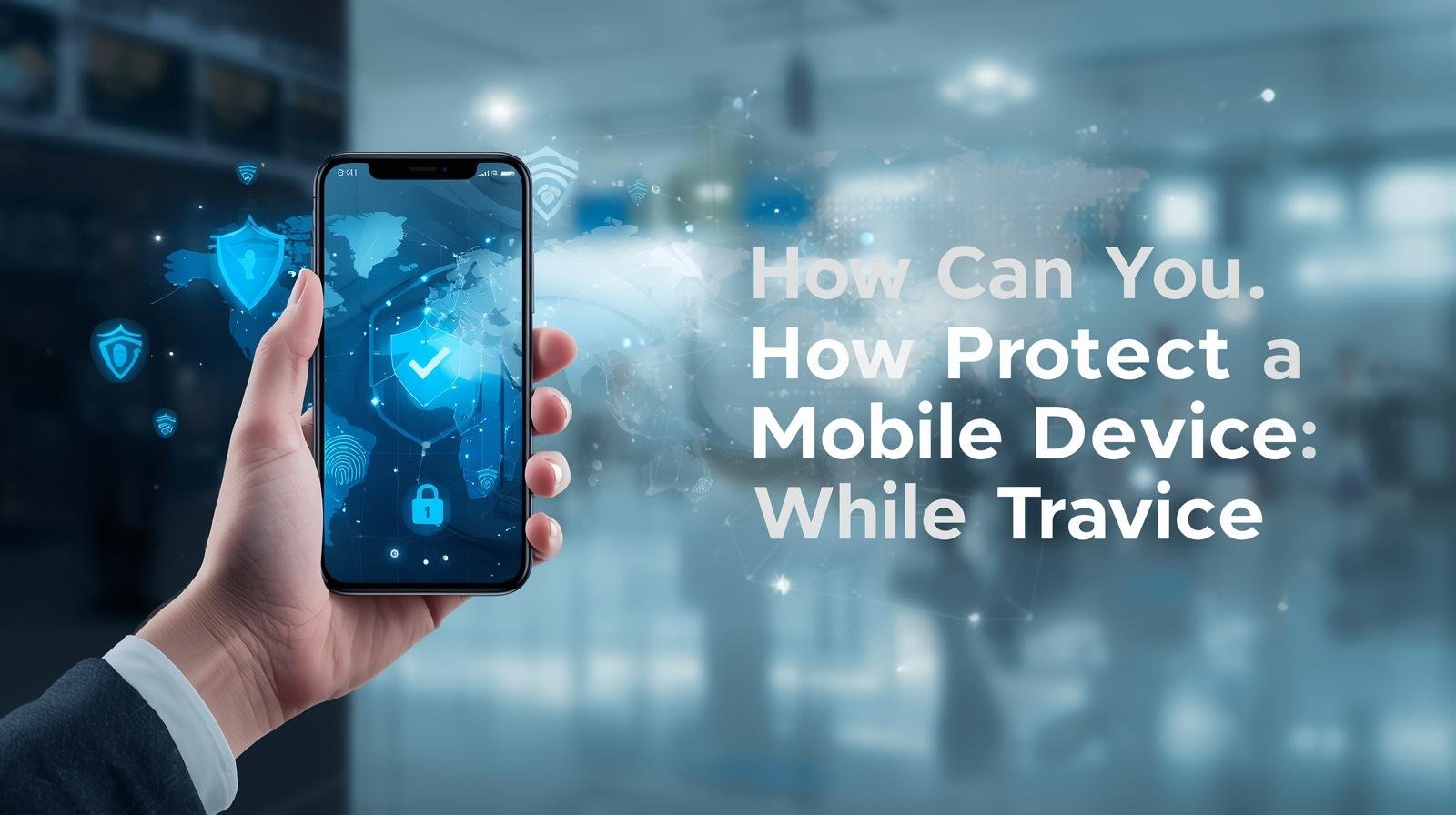How Can You Protect a Mobile Device While Traveling Our phones and tablets are more than just ways to talk to each other in this digital age. They keep our personal information, bank account numbers, travel documents, and even work files safe. Smartphones and tablets are even more important when you travel for work or fun, but they are also at greater risk. Travellers need to take steps to protect their devices from theft, loss, and cyberattacks on public Wi-Fi.
- Why it’s important to protect your phone when you travel
- Use biometric locks and strong passwords for Protect a Mobile Device While Traveling
- Update your software and apps
- Don’t use public Wi-Fi without protection.
- Turn on remote tracking and wiping for How Can You Protect a Mobile Device While Traveling
- Use accessories that protect against theft
- Make sure to back up your data often
- Be careful with charging stations
- Turn off Bluetooth and NFC when you’re not using them.
- Be Careful of Phishing Scams
- Get insurance for your device
- FAQs: How Can You Protect a Mobile Device While Travelling?
- Last Thoughts
In this article, we’ll talk about real ways to keep your phone safe while you’re travelling, both in terms of physical and digital security.
Why it’s important to protect your phone when you travel
Your phone is a lifeline when you’re not at home. You use it to find your way, book hotels, get flight information, make payments, and even get help in an emergency. If you lose access to your device, it could ruin your trip. A security breach could also put sensitive information at risk.
Some common risks are:
- Stealing or pickpocketing in busy places.
- Stealing data from Wi-Fi networks that aren’t secure.
- Malware or phishing attacks that come from apps that aren’t verified.
- Accidental damage because you aren’t used to the area.
With these risks in mind, the question is: how can you keep your phone safe while you’re on the go? Let’s look at some tried-and-true methods.
Use biometric locks and strong passwords for Protect a Mobile Device While Traveling
The first step to keeping your smartphone safe is to make sure that no one can easily get to it. Always use:
- A strong password or PIN (don’t use easy numbers like 1234 or your birthday).
- For extra safety and ease, use fingerprint or face recognition.
- Two-factor authentication (2FA) is a way to protect important accounts like email, banking, and social media.
This makes sure that your data stays safe even if your device is stolen.
Update your software and apps
Hackers often go after old software that has known security holes. Before you go
Make sure your Android or iOS operating system is up to date.
- Update all of your important apps.
- Remove any apps that aren’t needed and could be a security risk.
This not only makes your device run better, but it also makes it safer.
Don’t use public Wi-Fi without protection.
Wi-Fi in public places like airports, hotels, and cafes is useful, but it’s not always safe. Cybercriminals can get your data and steal your passwords or bank account information. To keep yourself safe:
- Encrypt your internet traffic with a Virtual Private Network (VPN).
- Turn off the ability to connect automatically to open Wi-Fi networks.
- When doing sensitive things like online banking, only use mobile data.
Turn on remote tracking and wiping for How Can You Protect a Mobile Device While Traveling
You can find, lock, or erase your phone from a distance on both Android and iOS devices. Before you leave, turn on these features:
- Find My iPhone (iOS).
- Find My Device (for Android).
If you lose your device or it gets stolen, you can keep people from getting into it by remotely wiping your personal data.
Use accessories that protect against theft
It’s just as important to protect yourself in the real world as it is online. Think about:
- Backpacks that are hard to steal because they have hidden zippers.
- Phone lanyards or straps to keep you from dropping your phone.
- Cases that are waterproof and shockproof for outdoor activities.
- Screen protectors that keep scratches and cracks from happening.
These extras lower the chance of losing or damaging things while you’re on the go.
Make sure to back up your data often
Think about how bad it would be to lose your device, along with all your travel photos and important files. To stop this from happening:
- Save your backup data to the cloud, like Google Drive, iCloud, or OneDrive.
- As an extra safety measure, keep an external hard drive or USB stick on hand.
- Turn on automatic backups for your documents, contacts, and photos.
This makes sure that your data is safe and easy to get to, even if your device is hacked.
Be careful with charging stations
There is a risk of “juice jacking” at public charging stations in airports or cafes. This is a type of cyberattack that installs malware through USB ports. To be safe:
- Bring a portable power bank.
- Use a cable that only charges or a USB data blocker.
- Prefer to charge directly from a wall outlet.
Turn off Bluetooth and NFC when you’re not using them.
If you leave Bluetooth and NFC (Near Field Communication) on, your phone is open to connections that aren’t authorised. Hackers can use these features to get into your device. Always:
- When you’re not using Bluetooth or NFC, turn them off.
- Connect only to devices you trust.
- Don’t use AirDrop or similar features to share files with people you don’t know.
Be Careful of Phishing Scams
Phishing emails and fake booking confirmations often go after people who are travelling. To keep yourself safe:
- Not clicking on links in emails or texts that seem fishy.
- Only get apps from official stores like the Apple App Store and Google Play.
- Before entering any information, make sure that travel or hotel websites are real.
Get insurance for your device
No matter how careful you are, accidents can still happen. If your phone is stolen, lost, or damaged, travel insurance or specific mobile device insurance can help you get your money back. Check the following before you leave:
FAQs: How Can You Protect a Mobile Device While Travelling?
1. Why is it important to protect your mobile device while travelling?
Travel increases the risk of theft, data breaches, and public Wi-Fi attacks, so securing your device keeps your personal and financial data safe.
2. Should I use public Wi-Fi when travelling?
Avoid public Wi-Fi whenever possible. If you must use it, connect through a VPN (Virtual Private Network) to keep your data encrypted.
3. How can I keep my phone safe from theft?
Use strong passwords, biometric locks, and tracking apps like “Find My iPhone” or “Find My Device”. Always keep your phone close and avoid leaving it unattended.
4. What’s the best way to back up my phone before a trip?
Back up your data to cloud storage or an external drive before travelling so you can recover important files if your device is lost or stolen.
5. How do I protect my phone from cyber threats while abroad?
Install security updates, use antivirus software, and disable automatic Bluetooth and Wi-Fi connections to prevent unauthorised access.
Last Thoughts
To keep your phone safe while you travel, you need to use both digital security measures and physical safety measures. Every step you take to protect yourself, like using strong passwords and VPNs or carrying anti-theft gear, lowers the risks. Taking care of your phone will make your trip easier and less stressful because it is your travel companion for directions, communication, and payments.
So, the next time you ask, “How can I keep my phone safe while I’m travelling?” remember these tips and make sure your phone’s safety is your top priority.





